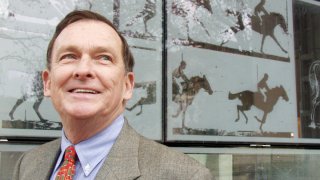
Thomas Staley, who led the University of Texas Harry Ransom Center cultural archive for 25 years and oversaw its growth into one of the world's leading literary and humanities research institutions, has died, the university announced Wednesday.
Staley was director from 1988 to 2013. Under his leadership, the Ransom Center acquired the archives of Nobel Prize winner J.M. Coetzee, Pulitzer Prize winners David Mamet and Norman Mailer, and David Foster Wallace among the works of more than 100 writers from around the U.S. and the world.
Staley died Tuesday at age 86, the school announced. No cause of death was given.
Staley's ability to acquire the works of literary heavyweights, some of whom had little or no connection to Texas or the university, pushed the Ransom Center toward the forefront of major collections, and made it competitive with Yale and Harvard and other institutions with established archives.
Get DFW local news, weather forecasts and entertainment stories to your inbox. Sign up for NBC DFW newsletters.
"Drafts and correspondence tell you the story of how it all happens," Staley said in 2009. "When you realize why a writer threw something away, you learn more about that work. You see the next scene that was written instead, and why it was better. You get a sense of how the puzzle comes together. And that's invaluable for students and scholars."
He also expanded the center's collection beyond literature with the archives of actor Robert DeNiro, photojournalist David Douglas Duncan and Watergate reporters Bob Woodward and Carl Bernstein.
The Woodward and Bernstein collection included notes, manuscripts, story drafts, court documents and other materials that the Ransom Center made available for researchers of the Watergate break-in and coverup scandal that led to the resignation of President Richard Nixon.
Texas News
News from around the state of Texas.
"Tom Staley was one of the most innovative archivist leaders in the country," Woodward said. "He oversaw the acquisition of Carl Bernstein and my Watergate papers, set up the Watergate displays and opening of our files."
Staley grew the Ransom Center's endowment from $1 million to more than $30 million to support acquisitions, internships, fellowships, education and programming.
A major renovation of the Ransom Center in 2003 created more than 40,000 square feet of public space and a gallery with permanent exhibits of some materials, including a Gutenberg Bible and the Niepce Heliograph, the world's oldest known surviving photograph.
Born in Pittsburgh on Aug. 13, 1935, Staley earned a Ph.D. at the University of Pittsburgh, and had been a professor of English, dean of the Graduate School, dean of the College of Arts and Sciences, and provost and vice president for academic affairs at the University of Tulsa before moving to Texas.
Staley also was an author and founding editor of the James Joyce Quarterly, which he edited for 26 years, and a former president of the James Joyce Foundation.
The collections that Staley oversaw at Texas "are a lasting legacy and for generations to come will stand as a record not only of our times but of one man's astute engagement with our culture," said Ransom Center Director Stephen Enniss, who succeeded Staley.



